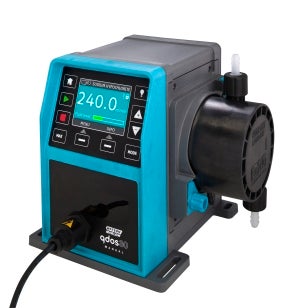Qdos Metering Pumps Solve Turbidity Testing Dilemma for Welsh Water

Until recently, turbidity testing at the Pontsticill Water Treatment Works in the Brecon Beacons National Park relied on the use of bellows pump technology. However, the inherent introduction of air in the samples was undesirable and led to false readings. Now though, relief has arrived in the shape Watson-Marlow’s new Qdos 30 metering pumps, which not only provide excellent suction lift, but do so without air locks.
"This is a clean water site and the quality of sample is very important," states Marek Cegielski, a process scientist and manager at Dŵr Cymru Welsh Water. "In the past we’ve tried other types of turbidity monitoring devices, such as dip probes, but without much success. We’ve even used bubble traps in conjunction with our bellows pumps, but we still fell short of 100% reliability. Of course, eliminating the need for bubble traps was one of the attractions of replacing one of our bellows pumps with the new Qdos 30 from Watson-Marlow."
Upstream benefits
Located around 3 miles north of Merthyr Tydfil, the Pontsticill Water Treatment Works draws its water from the Pontsticill Reservoir, a large body of water measuring some 102 hectares in surface area, and holding up to 3400 million gallons of water for supply to industry and the populous of South Wales. Completed in 1927 and served by the Taf Fechan river, Pontsticill is among the biggest and most important resources in the Dŵr Cymru Welsh Water portfolio. With this in mind, successful turbidity testing is vital.
Turbidity is a key test of water quality. It is defined as the cloudiness or haziness of a fluid caused by individual particles (suspended solids) that are generally invisible to the naked eye, similar to smoke in air. Water can contain suspended solid matter consisting of particles of many different sizes. While some suspended material will be large enough and heavy enough to settle rapidly to the bottom of a container if a liquid sample is left to stand (the ‘settleable’ solids), very small particles will only settle slowly or not at all if the sample is regularly agitated or the particles are colloidal. These small solid particles cause the liquid to appear turbid. In drinking water, the higher the turbidity level, the higher the risk that people may develop gastrointestinal problems.
Crystal clear solution
The Qdos 30 metering pump at Pontsticill is taking elutriant from a DAF (dissolved air flotation) filtration plant and lifting it approximately 3 metres before it passes through a turbidity meter and returns by gravity back into the flow. At this point the water has already been subjected to coagulation, flocculation and flotation, and is ready for final filtration processes.
Capable of delivering flow performance from 0.1 to 500 ml/min, the Qdos pump gives Dŵr Cymru Welsh Water a steady flow speed of 280 ml/min – and the emphasis here is very much on ‘steady’.
"Our main requirement is for a constant, pulse-free flow," says Mr Cegielski. "Previously we had tried fitting back valves to bellows pumps to stop the pulsing but in truth we couldn’t properly buffer the effect and still ended up with false readings."
Plain sailing
Installed in July 2012, the Qdos 30 is working well without any signs of air introduction or flow variation. Watson-Marlow’s innovative new Qdos range has been purposely designed to eliminate ancillary equipment and enhance productivity by delivering more accurate, linear, and repeatable metering than typical solenoid or stepper driven diaphragm pumps.
"So far, so good, as far as we’re concerned – when new technology comes along that has a clear advantage over existing market solutions, then we are always willing to give it a try," concludes Mr Cegielski. "In total we have four streams to monitor at Pontsticill, so if our existing Qdos 30 continues to meet expectations then we’ll place an order for a further three pumps."
Featuring all-new hardware and software, other water-related applications for Qdos 30 include disinfection and pH adjustment of drinking water and industrial process water, flocculation, and industrial cooling water preparation to list but a few.

